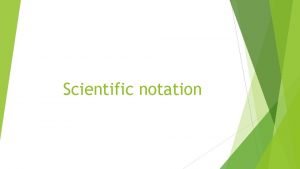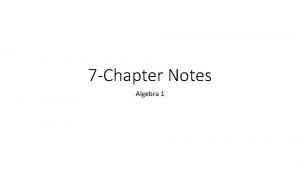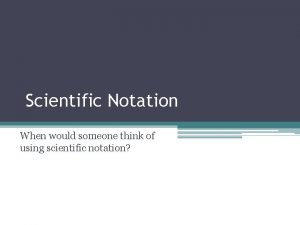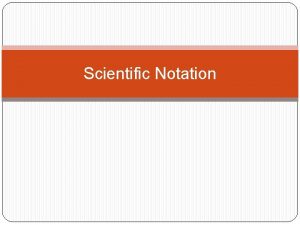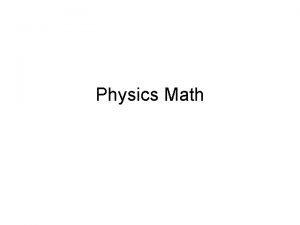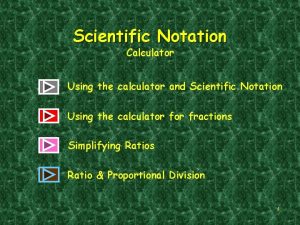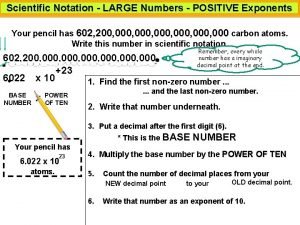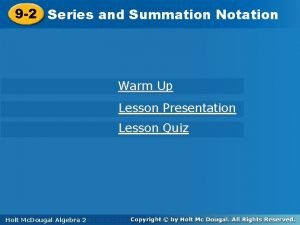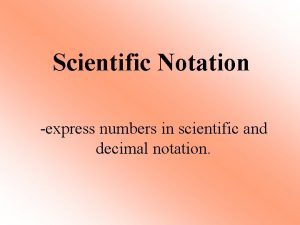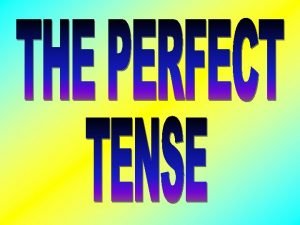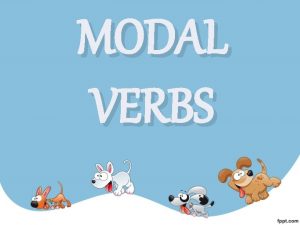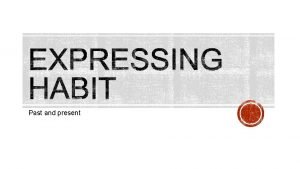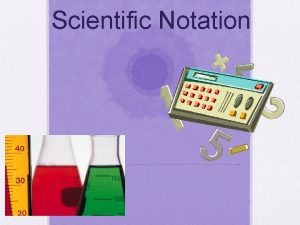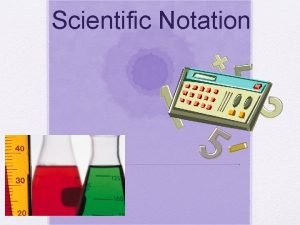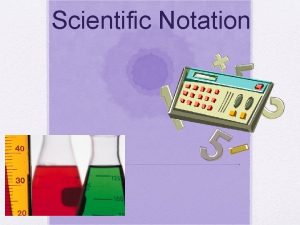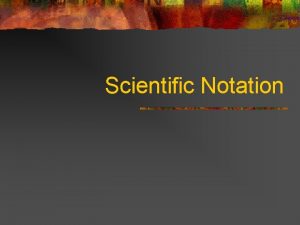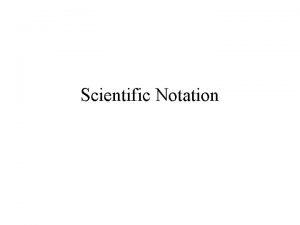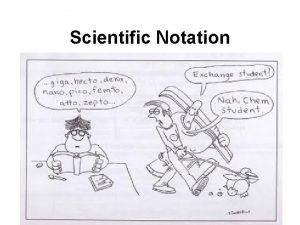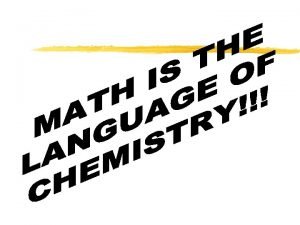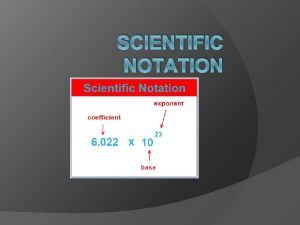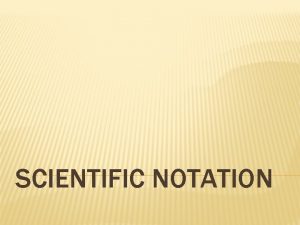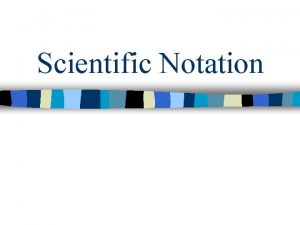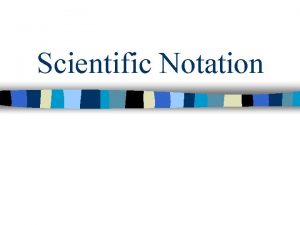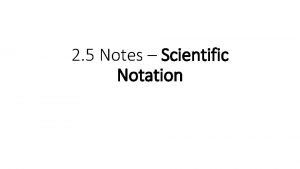Scientific Notation Scientific Notation is used to express
















- Slides: 16

Scientific Notation

Scientific Notation is used to express the very large and the very small numbers so that problem solving will be made easier. Examples: The mass of one gold atom is. 000 000 327 grams. One gram of hydrogen contains 602 000 000 hydrogen atoms. Scientists can work with very large and very small numbers more easily if the numbers are written in scientific notation.

How to Use Scientific Notation • In scientific notation, a number is written as the product of two numbers…. . a coefficient and 10 raised to a power.

4. 5 x 103 The number 4, 500 is written in scientific notation as ________. The coefficient is _____. 4. 5 The coefficient must be a number greater than or equal to 1 and smaller than 10. The power of 10 or exponent in this example is ______. 3 The exponent indicates how many times the coefficient must be multiplied by 10 to equal the original number of 4, 500.

If a number is greater than 10, the exponent will be positive _______ and is equal to the number of places the decimal must be moved to left the ____ to write the number in scientific notation.

If a number is less than 10, the exponent will be negative _______ and is equal to the number of places the decimal must be moved to right the ____ to write the number in scientific notation.

A number will have an exponent of zero if: …. the number is equal to or greater than 1, but less than 10.

To write a number in scientific notation: 1. Move the decimal to the right or left until you get a number between 1 and 10. 2. Write the new number and add x 10 (ex. 1. 5 X 10) 3. Count how many places the decimal had to be moved and that number becomes your exponent (ex. 1. 5 X 104) 4. If the decimal had to be moved to the left, the exponent is positive.

To write a number in scientific notation: 4. If the decimal had to be moved to the left the exponent is positive. Practice: 150000000 1. 5 x 108

To write a number in scientific notation: 5. If the decimal had to be moved to the right the exponent is negative. Practice: 0. 0023 2. 3 x 10 -3

Practice Problems Put these numbers in scientific notation. PROBLEMS 1). 00012 2) 1000 3) 0. 01 4) 12 5). 987 6) 596 7). 000 7 8) 1, 000 9). 001257 10) 987, 653, 000 11) 8 ANSWERS 1) 1. 2 x 10 -4 2) 1 x 103 3) 1 x 10 -2 4) 1. 2 x 101 5) 9. 87 x 10 -1 6) 5. 96 x 102 7) 7. 0 x 10 -7 8) 1. 0 x 106 9) 1. 26 x 10 -3 10) 9. 88 x 1011 11) 8 x 100

EXPRESS THE FOLLOWING AS WHOLE NUMBERS OR AS DECIMALS PROBLEMS ANSWERS 1) 4. 9 X 102 1) 490 2) 3. 75 X 10 -2 2). 0375 3) 5. 95 X 10 -4 3). 000595 4) 9. 46 X 103 4) 9460 5) 3. 87 X 101 5) 38. 7 6) 7. 10 X 100 6) 7. 10 7) 8. 2 X 10 -5 7). 000082

Using Scientific Notation in Multiplication, Division, Addition and Subtraction Scientists must be able to use very large and very small numbers in mathematical calculations. As a student in this class, you will have to be able to multiply, divide, add and subtract numbers that are written in scientific notation. Here are the rules.

Multiplication When multiplying numbers written in scientific notation…. . multiply the first factors and add the exponents. Sample Problem: Multiply (3. 2 x 10 -3) (2. 1 x 105) Solution: Multiply 3. 2 x 2. 1. Add the exponents -3 + 5 Answer: 6. 7 x 102

Division Divide the numerator by the denominator. Subtract the exponent in the denominator from the exponent in the numerator. Sample Problem: Divide (6. 4 x 106) by (1. 7 x 102) Solution: Divide 6. 4 by 1. 7. Subtract the exponents 6 - 2 Answer: 3. 8 x 104

Addition and Subtraction To add or subtract numbers written in scientific notation, you must…. express them with the same power of ten. Sample Problem: Add (5. 8 x 103) and (2. 16 x 104) Solution: Since the two numbers are not expressed as the same power of ten, one of the numbers will have to be rewritten in the same power of ten as the other. 5. 8 x 103 =. 58 x 104 so. 58 x 104 + 2. 16 x 104 =? Answer: 2. 74 x 104
 Express 4,980,000, 000 in scientific notation.
Express 4,980,000, 000 in scientific notation. Exponential function
Exponential function 462 na in scientific notation
462 na in scientific notation 586 400 000 in scientific notation
586 400 000 in scientific notation 462 na in scientific notation
462 na in scientific notation Express 549,000 in scientific notation.
Express 549,000 in scientific notation. Scientific notation simplify calculator
Scientific notation simplify calculator Express 602200 in scientific notation.
Express 602200 in scientific notation. Engineering notation definition
Engineering notation definition How to write a summation
How to write a summation What is 140 000 000 in scientific notation
What is 140 000 000 in scientific notation Present perfect tense is used to express
Present perfect tense is used to express Can modal verb
Can modal verb Using adverb clauses to show time relationships
Using adverb clauses to show time relationships Used to express very large or very small numbers
Used to express very large or very small numbers Habitual past tense
Habitual past tense Postfix to infix algorithm
Postfix to infix algorithm
